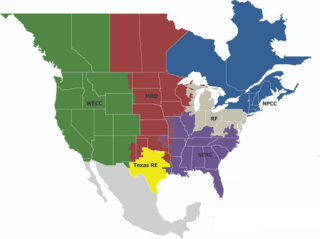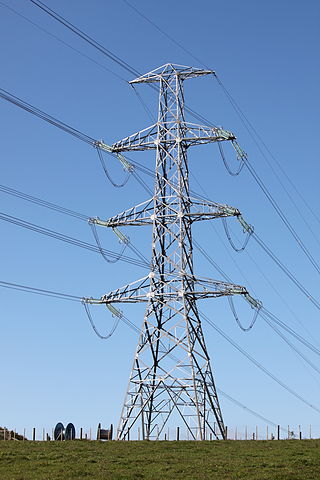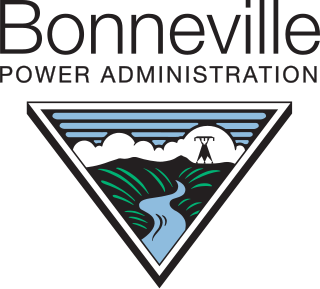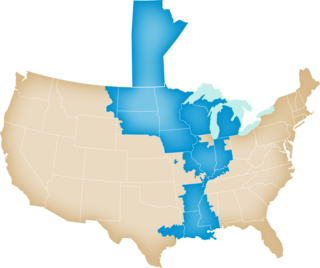
The Federal Energy Regulatory Commission (FERC) is an independent agency of the United States government that regulates the interstate transmission and wholesale sale of electricity and natural gas and regulates the prices of interstate transport of petroleum by pipeline. FERC also reviews proposals to build interstate natural gas pipelines, natural gas storage projects, and liquefied natural gas (LNG) terminals, in addition to licensing non-federal hydropower projects.

The North American Electric Reliability Corporation (NERC) is a nonprofit corporation based in Atlanta, Georgia, and formed on March 28, 2006, as the successor to the North American Electric Reliability Council. The original NERC was formed on June 1, 1968, by the electric utility industry to promote the reliability and adequacy of bulk power transmission in the electric utility systems of North America. NERC's mission states that it "is to assure the effective and efficient reduction of risks to the reliability and security of the grid".

The electric power industry covers the generation, transmission, distribution and sale of electric power to the general public and industry. The commercial distribution of electric power started in 1882 when electricity was produced for electric lighting. In the 1880s and 1890s, growing economic and safety concerns lead to the regulation of the industry. What was once an expensive novelty limited to the most densely populated areas, reliable and economical electric power has become an essential aspect for normal operation of all elements of developed economies.

The Bonneville Power Administration (BPA) is an American federal agency operating in the Pacific Northwest. BPA was created by an act of Congress in 1937 to market electric power from the Bonneville Dam located on the Columbia River and to construct facilities necessary to transmit that power. Congress has since designated Bonneville to be the marketing agent for power from all of the federally owned hydroelectric projects in the Pacific Northwest. Bonneville is one of four regional Federal power marketing agencies within the U.S. Department of Energy (DOE).

Columbia Generating Station is a nuclear commercial energy facility located on the Hanford Site, 10 miles (16 km) north of Richland, Washington. It is owned and operated by Energy Northwest, a Washington state, not-for-profit joint operating agency. Licensed by the Nuclear Regulatory Commission in 1983, Columbia first produced electricity in May 1984, and entered commercial operation in December 1984.

A regional transmission organization (RTO) in the United States is an electric power transmission system operator (TSO) that coordinates, controls, and monitors a multi-state electric grid. The transfer of electricity between states is considered interstate commerce, and electric grids spanning multiple states are therefore regulated by the Federal Energy Regulatory Commission (FERC). The voluntary creation of RTOs was initiated by FERC in December 1999. The purpose of the RTO is to promote economic efficiency, reliability, and non-discriminatory practices while reducing government oversight.

A transmission system operator (TSO) is an entity entrusted with transporting energy in the form of natural gas or electrical power on a national or regional level, using fixed infrastructure. The term is defined by the European Commission. The certification procedure for transmission system operators is listed in Article 10 of the Electricity and Gas Directives of 2009.

The Texas Interconnection is an alternating current (AC) power grid – a wide area synchronous grid – that covers most of the state of Texas. The grid is managed by the Electric Reliability Council of Texas (ERCOT).

Southwest Power Pool (SPP) manages the electric grid and wholesale power market for the central United States. As a regional transmission organization, the nonprofit corporation is mandated by the Federal Energy Regulatory Commission to ensure reliable supplies of power, adequate transmission infrastructure and competitive wholesale electricity prices. Southwest Power Pool and its member companies coordinate the flow of electricity across approximately 60,000 miles of high-voltage transmission lines spanning 14 states. The company is headquartered in Little Rock, Arkansas.

The Midcontinent Independent System Operator, Inc., formerly named Midwest Independent Transmission System Operator, Inc. (MISO) is an Independent System Operator (ISO) and Regional Transmission Organization (RTO). It provides open-access transmission service and monitors the high-voltage transmission system in the Midwestern United States, in Manitoba, Canada, and in a southern U.S. region that includes much of Arkansas, Mississippi, and Louisiana. MISO also operates one of the world's largest real-time energy markets. The 15 states covered by MISO are: Arkansas, Illinois, Indiana, Iowa, Kentucky, Louisiana, Michigan, Minnesota, Mississippi, Missouri, Montana, North Dakota, South Dakota, Texas, and Wisconsin.

ISO New England Inc. (ISO-NE) is an independent, non-profit regional transmission organization (RTO), headquartered in Holyoke, Massachusetts, serving Connecticut, Maine, Massachusetts, New Hampshire, Rhode Island, and Vermont.

PJM Interconnection LLC (PJM) is a regional transmission organization (RTO) in the United States. It is part of the Eastern Interconnection grid operating an electric transmission system serving all or parts of Delaware, Illinois, Indiana, Kentucky, Maryland, Michigan, New Jersey, North Carolina, Ohio, Pennsylvania, Tennessee, Virginia, West Virginia, and the District of Columbia.
There is a large array of stakeholders that provide services through electricity generation, transmission, distribution and marketing for industrial, commercial, public and residential customers in the United States. It also includes many public institutions that regulate the sector. In 1996, there were 3,195 electric utilities in the United States, of which fewer than 1,000 were engaged in power generation. This leaves a large number of mostly smaller utilities engaged only in power distribution. There were also 65 power marketers. Of all utilities, 2,020 were publicly owned, 932 were rural electric cooperatives, and 243 were investor-owned utilities. The electricity transmission network is controlled by Independent System Operators or Regional Transmission Organizations, which are not-for-profit organizations that are obliged to provide indiscriminate access to various suppliers to promote competition.
The Tres Amigas SuperStation was a project proposed in 2009 to unite North America’s two major power grids and one of its three minor grids, with the goals of enabling faster adoption of renewable energy and increasing the reliability of the U.S. grid.

The electricity sector in Sri Lanka has a national grid which is primarily powered by hydroelectric power and thermal power, with sources such as photovoltaics and wind power in early stages of deployment. Although potential sites are being identified, other power sources such as geothermal, nuclear, solar thermal and wave power are not used in the power generation process for the national grid.

The Southern African Power Pool (SAPP) is a cooperation of the national electricity companies in Southern Africa under the auspices of the Southern African Development Community (SADC). The members of SAPP have created a common power grid between their countries and a common market for electricity in the SADC region.

The electrical power grid that powers Northern America is not a single grid, but is instead divided into multiple wide area synchronous grids. The Eastern Interconnection and the Western Interconnection are the largest. Three other regions include the Texas Interconnection, the Quebec Interconnection, and the Alaska Interconnection. Each region delivers power at a nominal 60 Hz frequency.
Electrical grid security in the United States involves the physical and cybersecurity of the United States electrical grid. The smart grid allows energy customers and energy providers to more efficiently manage and generate electricity. Similar to other new technologies, the smart grid also introduces new security concerns.
The Western Resource Adequacy Program (WRAP) is an electricity planning and sharing agreement between electric utilities of the Western Power Pool. Its goals are to improve regional reliability and adequacy while decreasing costs by moving utilities from an individual utility framework to a regional approach. Program operations are based in Oregon.











